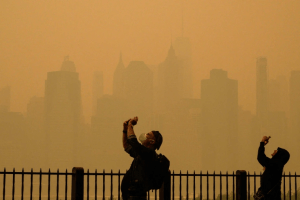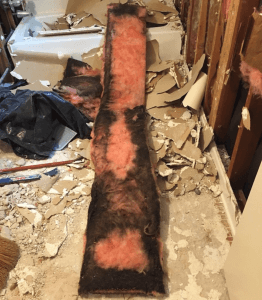Right now, the northern US is having an air quality crisis. Regardless of where you live, there are specific measures we should be taking to make homes safer during an air quality event or emergency.
Smoke from Canada’s wildfires is bearing down on northern states with little to no relief in sight. Anyone watching national news has seen the photos of New York, and many areas in the north, that are facing unprecedented air quality issues. No doubt residents of fire-prone areas like California are also well aware of the issues caused by wildfire pollution.

While smoke has a greater impact on those with respiratory issues, everyone should limit their exposure to it. Wildfire smoke contains gaseous pollutants as well as PM2.5. These tiny particulates pass right through most filter systems, including getting past the lungs and into your circulatory system. PM2.5 is a microscopic bad actor that causes serious health issues. Read more about The EPA’s strong warnings about wildfire smoke and PM2.5.
From train derailments causing chemical spills to wildfires, lately communities have been presented with air quality hazards and pollutants that would be better kept outside. Most of our older housing stock is filled with gaps, cracks, and pathways where dust, pollen and other pollutants leak in. These leaks are referred to as “contaminant pathways” by building scientist Joe Medosch. They allow inhabitants of houses to breathe air coming through the building materials, which adds to the pollutant issue plaguing most communities.
This raises the question, is air-sealing and insulation needed in newer “airtight” homes? For several years we’ve designed homes to be built tight and ventilated with a fresh air system. Most of these systems are known as ERV’s, HRV’s, and ventilating dehumidifiers. The ventilation in these homes are good but when the air is thick with wildfire pollutants bringing air in from outside can be problematic. Green Builder shared a great PSA on why these systems should be shut down for now.
with a fresh air system. Most of these systems are known as ERV’s, HRV’s, and ventilating dehumidifiers. The ventilation in these homes are good but when the air is thick with wildfire pollutants bringing air in from outside can be problematic. Green Builder shared a great PSA on why these systems should be shut down for now.
Many IDI contractors are in the business of home air sealing and have been advising customers on indoor air quality. In times of wildfire pollution, it’s wise to reach out to your customers, family or friends, and let them know what they can be doing. Here are some of the most important things anyone in an affected area should do to keep their air safe:
- Close off any fresh air systems that might amplify the amount of contaminants getting in.
- Replace the furnace, dehumidifier and other filters often.
- Replace fliters with the highest MERV rating possible for your unit.
- MERV 13 or better is the lowest that begins to block PM2.5
- Run a blower door test to find where your building leaks are.
- Add air-sealing insulation to buildings or homes.
- Start at the top. Stopping stack effect should be your first priority.
- Sealing the bottom is next. Top of basements, sealing crawl spaces etc.
- Continue air sealing the home by replacing weatherstripping, fixing air leakage and eliminating contaminant pathways.
- Here’s a super cool air scrubber hack from Dr. Allison Bailes that can help families that want more air filtration in their homes without making a large investment.
- Don’t store chemicals, pesticides or other irritants inside your air sealed home, especially with the fresh air system turned off.
- Check homes for Radon or other soil gasses both before and after air sealing.
- Tune into reliable news sources and limit outdoor activity when outdoor air quality is at its worst.
Remember, you may drink half a gallon of coffee, water, or some form of liquid today, and your body has organs and systems to filter what’s in that liquid. You are also going to breathe about 3000 gallons of air today that may be filled with things that could inflame your respiratory system or even bypass it and make it directly into your blood stream. No doubt, fresh air from outside can be better than the air inside, but what do you do when it’s not? Homes should be our sanctuaries. With that in mind, air-sealing homes and having ways to filter and protect your air quality, should be a priority.
Don’t forget the 25C tax credit and other rebates are out there to help people afford the costs of air-sealing and insulating their homes. Remember that you can be your local expert at creating healthier and more comfortable living and working environments. In this time of seasonal wildfires and air pollution, you’re providing healthier air to your customers when you offer air-sealing home services.
If you have questions about air sealing homes or buildings, finding an IDI contractor in your area, or any of the products or training at IDI, reach out to your local branch or any of us at IDI, where we look forward to earning your business every day.